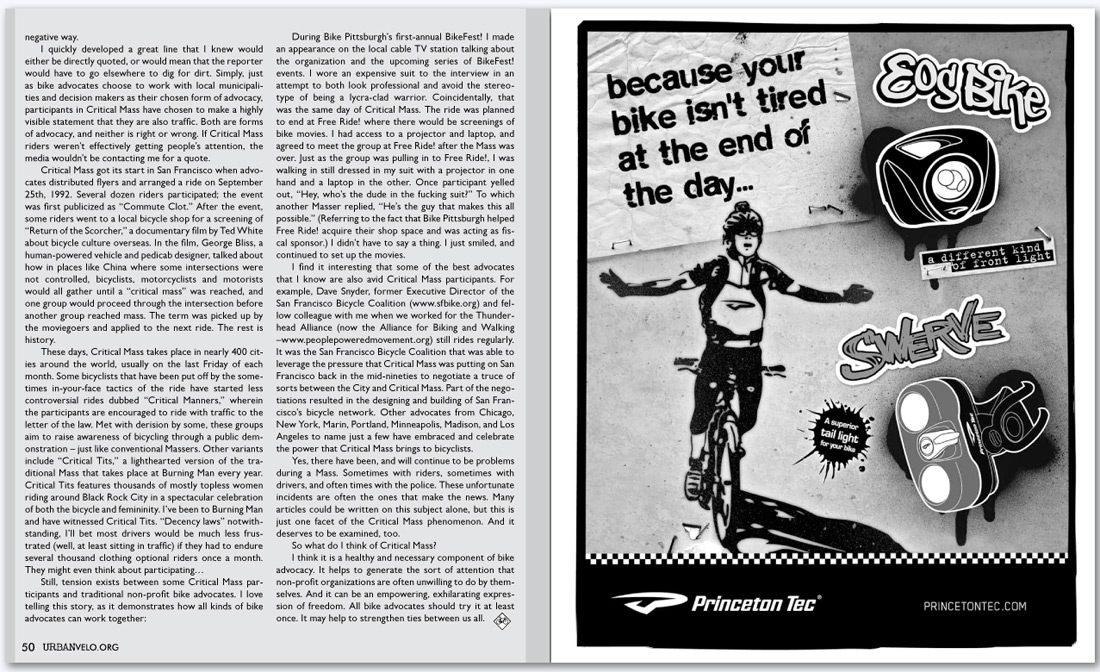

|
||||
|
I quickly developed a great line that I knew would either be directly quoted, or would mean that the reporter would have to go elsewhere to dig for dirt. Simply, just as bike advocates choose to work with local municipalities and decision makers as their chosen form of advocacy, participants in Critical Mass have chosen to make a highly visible statement that they are also traffic. Both are forms of advocacy, and neither is right or wrong. If Critical Mass riders weren’t effectively getting people’s attention, the media wouldn’t be contacting me for a quote. Critical Mass got its start in San Francisco when advocates distributed flyers and arranged a ride on September 25th, 1992. Several dozen riders participated; the event was first publicized as “Commute Clot.” After the event, some riders went to a local bicycle shop for a screening of “Return of the Scorcher,” a documentary film by Ted White about bicycle culture overseas. In the film, George Bliss, a human-powered vehicle and pedicab designer, talked about how in places like China where some intersections were not controlled, bicyclists, motorcyclists and motorists would all gather until a “critical mass” was reached, and one group would proceed through the intersection before another group reached mass. The term was picked up by the moviegoers and applied to the next ride. The rest is history. These days, Critical Mass takes place in nearly 400 cities around the world, usually on the last Friday of each month. Some bicyclists that have been put off by the sometimes in-your-face tactics of the ride have started less controversial rides dubbed “Critical Manners,” wherein the participants are encouraged to ride with traffic to the letter of the law. Met with derision by some, these groups aim to raise awareness of bicycling through a public demonstration – just like conventional Massers. Other variants include “Critical Tits,” a lighthearted version of the traditional Mass that takes place at Burning Man every year. Critical Tits features thousands of mostly topless women riding around Black Rock City in a spectacular celebration of both the bicycle and femininity. I’ve been to Burning Man and have witnessed Critical Tits. “Decency laws” notwithstanding, I’ll bet most drivers would be much less frustrated (well, at least sitting in traffic) if they had to endure several thousand clothing optional riders once a month. They might even think about participating… Still, tension exists between some Critical Mass participants and traditional non-profit bike advocates. I love telling this story, as it demonstrates how all kinds of bike advocates can work together: During Bike Pittsburgh’s first-annual BikeFest! I made an appearance on the local cable TV station talking about the organization and the upcoming series of BikeFest! events. I wore an expensive suit to the interview in an attempt to both look professional and avoid the stereotype of being a lycra-clad warrior. Coincidentally, that was the same day of Critical Mass. The ride was planned to end at Free Ride! where there would be screenings of bike movies. I had access to a projector and laptop, and agreed to meet the group at Free Ride! after the Mass was over. Just as the group was pulling in to Free Ride!, I was walking in still dressed in my suit with a projector in one hand and a laptop in the other. Once participant yelled out, “Hey, who’s the dude in the fucking suit?” To which another Masser replied, “He’s the guy that makes this all possible.” (Referring to the fact that Bike Pittsburgh helped Free Ride! acquire their shop space and was acting as fiscal sponsor.) I didn’t have to say a thing. I just smiled, and continued to set up the movies. I find it interesting that some of the best advocates that I know are also avid Critical Mass participants. For example, Dave Snyder, former Executive Director of the San Francisco Bicycle Coalition and fellow colleague with me when we worked for the Thunderhead Alliance (now the Alliance for Biking and Walking) still rides regularly. It was the San Francisco Bicycle Coalition that was able to leverage the pressure that Critical Mass was putting on San Francisco back in the mid-nineties to negotiate a truce of sorts between the City and Critical Mass. Part of the negotiations resulted in the designing and building of San Francisco’s bicycle network. Other advocates from Chicago, New York, Marin, Portland, Minneapolis, Madison, and Los Angeles to name just a few have embraced and celebrate the power that Critical Mass brings to bicyclists. Yes, there have been, and will continue to be problems during a Mass. Sometimes with riders, sometimes with drivers, and often times with the police. These unfortunate incidents are often the ones that make the news. Many articles could be written on this subject alone, but this is just one facet of the Critical Mass phenomenon. And it deserves to be examined, too. I think it is a healthy and necessary component of bike advocacy. It helps to generate the sort of attention that non-profit organizations are often unwilling to do by themselves. And it can be an empowering, exhilarating expression of freedom. All bike advocates should try it at least once. It may help to strengthen ties between us all. |
|
|